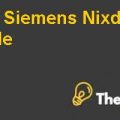
3.) How much value can be created for the firm as a whole by eliminating the dual-class structure?
The controlling power of a share increases the value of the shares to a certain level. This statement can be proved with the fact that if any of the Sulzbergers sold their valuable controlling rights of Class B shares in the open market, they could cash out the billions of dollars. Thus, the arrangement of dual-share structure prevented the family members from doing so.
Just after the announcement by MSIM, the company’s share witnessed a growth of 1.3% at $25.34 on the NYSE. This showed the positive feedback of the investors and analysts for the action of declassifying the shares.
MSIM’s claim was correct that the management was accountable to the family rather than to the shareholders who had invested a large amount of capital in the company. Buying the Boston Globe at the highest price ever, investment in Manhattan despite the downsizing of staff at that time and high spending on stock re-purchase were some of the series of wrong decisions taken by NYT.
The value that can be created for the firm as a whole by eliminating the dual-class structure can be calculated by the valuation method of P/E or EV/EBITDA. MSIM also claimed that by improving the financial and operational performance of the business through de-classification of shares, the gap between the market price of the stock and its intrinsic value will be reduced. So the market value of the company’s stock will be its intrinsic value.
The valuation ratio, EV/EBITDA is used for comparability between the peers. It indicates the growth rate and expected returns of the company. The enterprise value is calculated by:
EV = Mkt. Cap of equity + Preferred Stock + Debt – Cash Equivalents in excess of business needs for one year.
Since the company does not have any preferred shares and the data for cash equivalents in excess of business needs for one year are not visible, the EV is calculated by adding up market capital of the equity and the interest bearing debt. The EBITDA for the last twelve months is already calculated. With these figures, the EV/EBITDA is calculated to be 11.31 times. This means that the growth prospects of the company in the current situation are already as high as 11 times, which will increase even more if the de-classification of the shares is observed.
According to the P/E ratio, the valuation is done by multiplying the current P/E ratio with the future expected EPS to calculate the share price or the intrinsic value of the company’s stock. The price is calculated by multiplying market price of the stock with the number of shares outstanding whereas the net income of the company is considered as the earning. The same calculation can be done by dividing the share price to the current EPS.
For NYT, the P/E ratio is 20.74 times. This elaborates the high long term prospects of the company. The company’s stock has fallen by 52% since 2002 however; the new technology can help the company to grow its earning. So, the expected increase in the EPS with a pessimistic view will be around 14%. With this figure, the value of the stock must be around $27.52 per share if the dual-class structure is eliminated.
4.) How should the family behind New York Times respond to MSIMs proposal?
The family behind New York Times was very concerned about the MSIM’s proposal. Thus Arthur Sulzberger, Jr. had to decide and take action regarding this subject matter as he must decide between maintaining ethical relationships of trust with all the parties involved.
He had the duty towards shareholders as a Chairman of NYT and as the Times publisher. He also had to maintain the journal’s superior quality for the benefit of its readers, and his responsibility as a visible head of the latest generation of Sulzbergers, to honour his great-grandfather’s will to preserve the Times “free of ulterior influence, unselfishly devoted to the public welfare” for subsequent generations.
With the responsibility towards the shareholders, the company announced a 6.1% increase in dividends to a $1.75 per share for its Class A and B shares to communicate the long-term prospects and confidence in the company’s shares........................................
This is just a sample partial case solution. Please place the order on the website to order your own originally done case solution.













